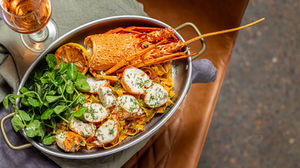Long-Standing Tradition Fused with Contemporary Innovation
- Liane Morris
- Aug 16, 2022
- 6 min read
Updated: Sep 23, 2022

The history of Hungerford Hill winery is long and complex. Home to the only two-hatted restaurant in the Hunter Valley, Muse, the quality of the experience for visitors to the cellar door is second to none, backed up by winemaking tradition and innovation led by Chief Winemaker Bryan Currie. Hungerford Hill is tradition fused with innovation at its finest.
HISTORY
Originally a Hungerford family owned and run cattle farm that spread to the current site of Hunter Valley Gardens and Cypress Lakes Resort, Hungerford Hill was established as a vineyard by accountant and entrepreneur John Parker in 1967. The Australian wine industry was experiencing a renaissance at the time, with many professionals and investors keen to explore the new interest in table wine as an accompaniment to food, with sherry and port becoming less popular. Parker opened a cellar door in 1970 and developed the first wine tourism complex a couple of years later. By 1985 however, Parker lost control of the business in a hostile takeover, and the winery was purchased by Southcorp, who also acquired vineyards in the Tumbarumba and Hilltops regions to add to the label. Despite this, the brand languished until John Kirby purchased the property in 2002.
Under Kirby, the label flourished, and the current iconic cellar door at One Broke Road was built, designed by architect Walter Barda, meant to resemble a wine barrel. The next period saw the brand develop a reputation for premium quality wines, and then, in 2016, Kirby sold to Sam Arnaout of Iris Capital, now the current owner. Arnaout also acquired Sweetwater vineyard and Wyndham Estate in addition to the Dalwood brand. Dalwood was the original name of Wyndham Estate, which is widely recognised as one of the oldest surviving vineyards in Australia, having been established by George Wyndham in 1828.
The opportunity to return the Dalwood brand to the property is an acknowledgement of the property's importance to the viticulture history of the country and is a wonderful legacy for Arnaout.
THE WINEMAKER

When Arnaout took over at Hungerford Hill, he employed Bryan Currie as Winemaker. Currie had worked at Westend Estate and McWilliams for many years and had spent some time in China, where his wife was working. He was attracted to the role because it was based in NSW and utilised fruit from Tumbarumba.
"I'd been working with fruit from this region all my career, and I wanted to continue to do that," said Bryan.
"At the same time, I loved the idea that Hungerford Hill had fruit available from several different climates, enabling us to create a full range of wines."
Bryan also spent his early career in Southern Italy, which has provided invaluable experience in working with fruit from hotter and drier climates.
"The last decade has seen an expansion of Southern European varieties that work in these hotter climates. Our climate is changing, and I'm enjoying experimenting with varieties such as Tempranillo and Graciano. Most of our wines are single vineyard with a concentration of character that shows the terroir and place that it's grown in. It's important to me that the personality of the wine comes from the place, not the winemaker."
THE VINEYARDS & WINES
Each vineyard provides a unique climate and soil that affects the wines produced. Dalwood Estate's sandy soil and riverbank flats produce lighter style fragrant Shiraz. The Dalwood Estate cellar door was closed when covid hit and hasn't reopened. It has become a venue for hire and is extremely popular for weddings, with the river frontage creating the perfect backdrop.
Sweetwater Estate has red clay over limestone and produces a heavier, richer style of wine with more body and depth. It doesn't have a cellar door and has never been open to the public, although private members-only events are held there. The unique beauty of the imposing French Gothic-style dining room, resplendent with original features and overlooking the magnificent Sweetwater Estate and residence, is reminiscent of a European chateau of yesteryear and makes for an exceptional members-only experience.
Hungerford Hill has heavier dark clay soil that produces a blacker, denser wine and is home to the iconic cellar door, Muse restaurant and Sculpture Courtyard. Hilltops is a cool climate with granite-based soil and grows Sangiovese, Tempranillo and Malbec. Tumbarumba is a cold climate that produces softer fruit for Pinot Noir and Pinot Meunier.

"We're having a lot of fun creating Spanish-style wine using the early ripening Tempranillo and balancing that out with the late-ripening Graciano from Hilltops. It's a very different wine from our standard with no real oak influence. It's a balanced wine, and combining the two varieties; it works better."
"We’re proud to offer a wine for every palate and every occasion with wines from multiple regions – the full NSW experience. In terms of red wine, we’ve got our Classic, Single Vineyard, Epic Shiraz, Heavy Metal and Museum Release. The Heavy Metal is a classic Aussie blend of Shiraz Cabernet - a richer, tannic style of red, and we blend from different vineyards for that one. Our Epic Shiraz is the best red wine of each year. It’s carefully selected and has hailed from Sweetwater for the last three or four years. It’s the best fruit, from the best batch from the best barrels – we really pick the eyes out of it to make it truly special.”
In 2020 Bryan began experimenting with creating vegan-friendly wines.
“Traditionally, when you’re fining or softening the wine, you use animal proteins like milk or egg white. With the number of people identifying as vegan increasing every year, we decided to create a wine that everyone can enjoy, including vegans. It’s an attempt to increase accessibility. We’ve been experimenting with plant proteins like pea or potato starch. It hasn’t affected the taste of the wine at all, and it’s wonderful to be able to offer a vegan-friendly wine.”
“Similarly, we are aware that a lot of people are seeking preservative-free wines because they may have reactions to sulphites. Unlike plant proteins, going preservative-free alters the wine's taste and texture. It’s less fruity, loses intensity and is more textural and savoury. It’s almost a different category of wine altogether, but we’ve been creating preservative-free wines for some time now.”
THE FUTURE
Hungerford Hill has a strong foothold in the history and traditions of winemaking in the Hunter Valley and NSW as a whole, with world-class, award-winning wines representing the full range of styles and regions. So, what’s next?
“I’m keen to push the envelope,” said Bryan. “What other styles of wine can we make? Some of the greatest wines in the world are often blends, so I’m excited to be experimenting in this area. In addition, we’ve got some impressive changes coming to the site at Hungerford Hill. We’re looking to develop the site so that it is closer in intent to the original design. Like the Opera House, the building at One Broke Road was never fully realised to the architect’s design; they ran out of money at the time. The architect, Walter Barda, had a grander vision which we’re hoping to achieve sometime in the near future.”
“To be successful in these challenging times, it’s important to be flexible and to be able to adapt. The Hunter Valley has always been a tricky place to farm, and it’s no different with a vineyard. It can be subtropical in summer and dry and cold in winter. This variability in seasonal climate makes the Hunter Valley wines stand out, and the trick is to be relaxed and not too stressed about it. Our different growing regions, all within NSW, give our wines the character that defines them.”
FOOD & TASTINGS
Muse Restaurant is located within the Hungerford Hill complex and is the only two-hatted restaurant in the Hunter Valley. It was opened in 2009 and aims to be one of Australia’s finest regional restaurants serving contemporary Australian cuisine with a focus on local produce. This world-class food complements the wine, with the restaurant working closely with the winery to produce sought-after events that are sold out months in advance.
One of the most popular offerings at Hungerford Hill is the Epic Tasting Experience for $60pp. This award-winning mini-degustation of Hungerford Hill wines matched with bite-sized dishes created by Muse Restaurant is the ideal treat for all travellers, foodies and wine lovers, local or visiting.
Coming up on Saturday 26 November is the Yuletide Celebration Luncheon that offers a sensational five-course menu matched with a selection of premium aged and new release Hungerford Hill wines complete with entertainment. At just $249 pp, it makes the perfect start to the annual festive season.
A Standard Tasting is just $10 pp and includes eight wines from an extensive list with knowledgeable staff on hand to talk you through all your selections. Bookings can be made through the website at www.hungerfordhill.com.au.
However you choose to experience Hungerford Hill, its long-standing tradition coupled with innovation, the sheer breadth of choice that represents the full spectrum of the wines of NSW and the dedication to quality will guarantee an enjoyable occasion that you will want to repeat time and again.














































































































